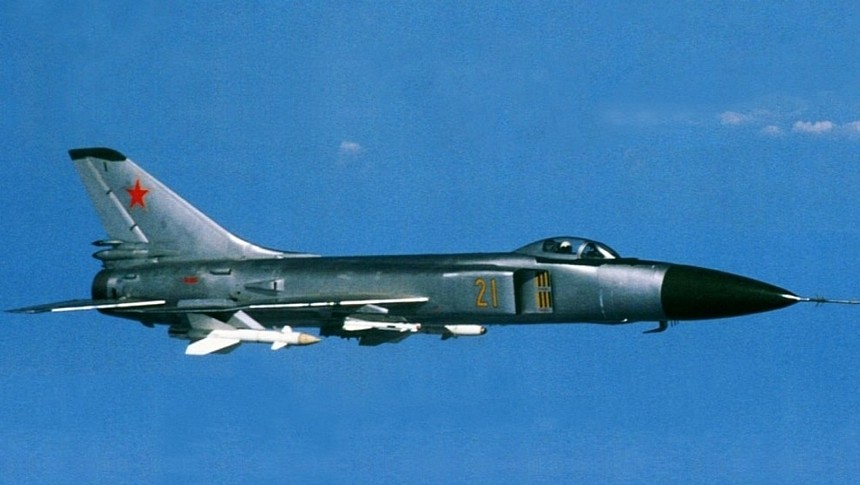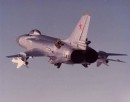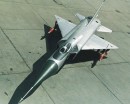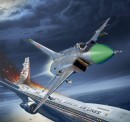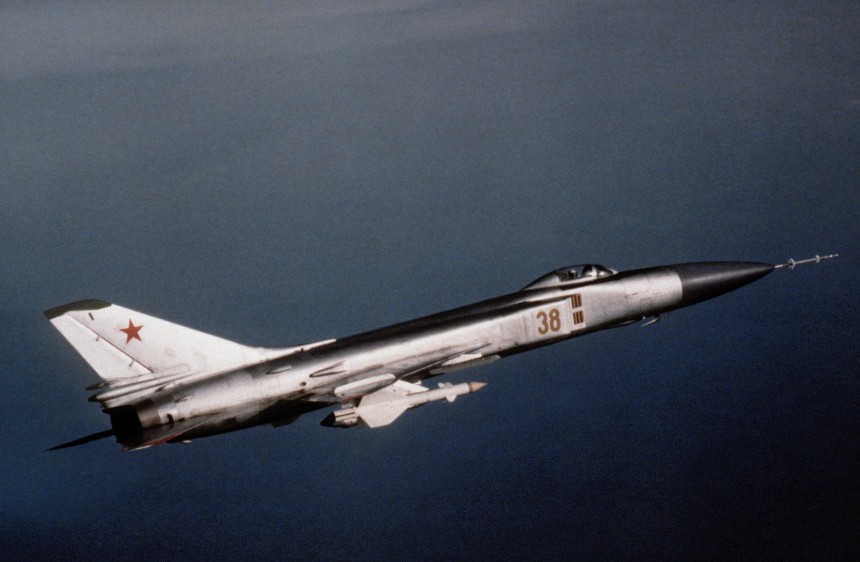There's a handful of military planes that, no matter the specifics of their backstory, will always be defined by one incident that secured its place in history books for the rest of time. Whether it's the B-29 bomber for dropping twin nukes over Japan or the DC-7 airliner for the loss of one of Major League Baseball's all-time great players aboard, the incidents these airplanes are associated with are almost more well-known than the planes themselves. But one fighter jet often slips people's attention despite similar circumstances. A plane that, with one flick of the missile switch, ensured it would live in infamy. But that's not even the half of the story.
This is the story of the Sukhoi Su-15, the twin-engine Soviet interceptor defined by Korean Air Lines Flight 007. But before those fateful events on the evening of September 1st, 1983, the Su-15 was just the next in line of a lineage of Sukhoi fighter-bombers and interceptors tasked with fending off that perpetual thorn in the Warsaw Pact's side that was NATO strategic bombers. Be it the Boeing B-52 or the British V-Bomber trio, the Soviet Union had a vested interest in keeping NATO bombers at bay from the end of World War II until their collapse 45 years later.
Among the Soviet design bureaus tasked with building jets for this purpose included Sukhoi, one of modern-day Russia's oldest and most historic aerospace contractors. From the mid-to-late 1950s onward, Sukhoi's Su-9s and Su-11s derived from the Su-7 fighter-bomber supplemented true-to-form fighters like the Mikoyan-Gurevich MiG-19 and MiG-21. These were the first line of defense against American bombers if a squadron ever pierced Soviet airspace with cruel intentions. Though Sukhoi's contemporary crop of interceptors were impressive machines, the considerable heights at which bombers like the Boeing B-52 Stratofortress tended to fly gave Soviet pilots fits.
Among the issues with high-altitude bomber interception, the biggest headache was a lack of radar systems powerful enough to detect incoming aircraft across a broad spectrum of distances and altitudes. Effective counters to American missile countermeasures systems were just another headache to add to the list. As the awesome capabilities of the Stratrofortress and the British Vulcan made themselves more visible, Sukhoi knew the Su-9 and Su-11 would be wholly insufficient at countering NATO threats by themselves. A novel, all-new platform was needed to ensure Soviet air power could match the capabilities of its adversaries. As Sukhoi soon made apparent, there were more than a few approaches to getting this job done.
Sukhoi's first crack at making the Su-9 platform more capable came in the form of the prototype T-49. The T-49 utilized the Su-9's fuselage and single Lyulka AL-7 turbofan engine while replacing its trademark front shock cone air inlet with a covered radome large enough to carry a new RP-22 Oryol-D ("Eagle") radar suite capable of identifying B-52s and other NATO-aligned strategic bombers. A second prototype, the T-5, sported similar characteristics but with its single engine swapped for twin Turmansky R-11 turbojets also found in the MiG-21. Combine the twin-engine layout of the T-5 with the powerful radar of the T-49, and what resulted was the USSR's next front-line interceptor, the Su-15 (NATO report name: Flagon).
With dimensions of 21.44 m (70.3 ft) long and an 8.6-meter (28.2-ft) wingspan in early iterations, the Su-15 was similarly proportioned to contemporary American interceptors of the day like the Convair F-106 Delta Dart. A maximum takeoff weight of 17,350 kg (38,250 lbs) was only slightly lighter than the F-106A's-18,975 kg (41,831 lb) max as well. This big beast of a jet made its first test flight on May 30th, 1962. But not before Sukhoi and another Soviet design bureau, Yakovlev settled a row about who would get production space at the Soviet state-run factory in Novosibirsk, Russia.
So the story goes, Yakovlev had already contracted the production facility to build their Yak-28 fighter bomber when Sukhoi reached out to see if any extra space was available for their own aircraft. The resulting spat ultimately delayed the flight testing of the Su-15. When this was all settled, Soviet pilots found the early Su-15's takeoff and landing characteristics to be less than stellar. As it turned out, the big, heavy delta wings found on early Su-15s turned the jet into an absolute dog's breakfast to fly. Even with a redesigned blended wing with extended tips in the 11th production series, the Su-15's takeoff speed of 370 km/h (230 mph) was downright head-spinning.
For context, a modern Boeing 737 can take off after accelerating to around 150 mph (250 km/h). Yeah, not all that wow-worthy for a jet built at the same time as MiG-21s and F-104s. It'd take until 1969 for the first Su-15s with revised wings to leave Soviet factories. But with enough of the significant flaws worked out, Soviet pilots could finally use the Su-15's finer aspects. For starters, the Su-15 flew with six underwing pylons that hauled up to 1,500 kg (3,300 lb) of ordinance. Under these pylons typically sat Vympel R-60 short-range, infrared air-to-air missiles and Kaliningrad K-8 medium-range AAMs with a choice of semi-active, radar-guided, or infrared seeker heads.
Compared to early American AIM-7 Sparrows that couldn't hit the broad side of a barn, or AIM-9 Sidewinders, known for craving the forbidden heat signature known as the Sun, Soviet missiles were at least on par with their adversaries rather than flat-out worse. If Su-15s needed to fly a multi-role mission, everything from FAB-500 1,100-lb (500 kg) bombs, UG-16 unguided rocket pods, and even twin 23 mm Gryazev-Shipunov GSh-2 autocannon pods could make quick work of even heavily-armored ground targets. Couple that with a climb rate of 228m/s (750 ft/s, 45,000 ft/min) and top speed purported between Mach 2.1 and 2.5, and the Su-15 was undoubtedly an extremely potent airframe despite its flaws.
Throughout the 1960s and 70s, Soviet Su-15 squadrons cut their teeth in training exercises meant to mimic the flying mannerisms of the American B-52 and the British V-Bombers, including the Vulcan. Intercepting Lockheed U-2 spy planes flying north of 70,000 feet (21,336 m) was also a top priority among these Red Air Force pilots. Their Volkov Taifun radars, equipped on later Su-15Ts (Flagon-E) and TMs (Flagon-F), were designed to counter these American high-altitude threats directly. They were only ever turned on once the pilot was within striking distance of a target, where its counter-countermeasures-optimized radar could work most effectively.
But instead of targeting Stratofortresses and Vulcans, Su-15s gained a reputation for harassing and occasionally shooting down foreign civilian airliners unfortunate enough to stray over communist airspace. Don't be fooled; Korean Air Flight Flight 007 is just the tip of the iceberg of questionable decisions attributed to Su-15 pilots. On April 20th, 1978, Korea Air Lines Flight 902, consisting of a Boeing 707-321B carrying 109 souls, veered into Soviet Airspace before being intercepted by Soviet Air Force Su-15s over the port city of Murmansk.
After failing to signal the passenger jet over radio comms or through visual-range wing rocking, Soviet pilot Alexander Bosov fired two R-60 heat-seeking missiles at the 707, with one slicing off a portion of its left wing. The Korean jet managed to make an emergency landing with only two fatalities recorded, with one upon impact of the missile. But shockingly, the Soviets sent an invoice to the South Korean government and Korean Air Lines for US$100,000 ($448,700 today) after the incident.
Three years later, a Soviet Su-15 based out of an air base in Georgia collided with an Argentine Transporte Aéreo Rioplatense (TAP) Canadair CL-44 when it too strayed into Soviet airspace over modern-day Armenia. All four aboard the CL-44, including a British national, died in the incident. The Soviet pilot ejected safely and later claimed his jet was deliberately and that the plane was secretly carrying a cache of weapons secretly purchased from the Israelis by Iran during the Iran-Iraq War. But as far as historic moments in the 20th century go, the Su-15 will always be joined at the hip to its role in the shootdown of Korean Air Lines Flight 007.
As the Su-15 pilot that night, Gennadiy Osipovich recalled, he fired a burst from his autocannons as a warning shot before firing two K-8 missiles and killing all 269 soldiers on board. During a period of Soviet paranoia around alleged secret spy planes disguised as airliners, Flight 007 became a lens through which the West could understand the lengths the Soviets were willing to go to protect its home air space. As if to top the cherry on the infamy cake, a Su-15 is popularly blamed for the death of Yuri Gagarin after one buzzed past his cockpit while flying a two-seater MiG-15, causing his aircraft to be caught in the Sukhoi's wingstream and sending him crashing to his death.
The Su-15 continued to serve the Soviet Air Force and the subsequent Air Forces of Russia and Ukraine until 1996. In this time, the type never saw real combat, meaning it's only ever killed civilians. Today, only a handful of the 1300 or so Sukhoi Su-15 airframes made remain on display in museums across Ukraine and Russia.
.
Among the Soviet design bureaus tasked with building jets for this purpose included Sukhoi, one of modern-day Russia's oldest and most historic aerospace contractors. From the mid-to-late 1950s onward, Sukhoi's Su-9s and Su-11s derived from the Su-7 fighter-bomber supplemented true-to-form fighters like the Mikoyan-Gurevich MiG-19 and MiG-21. These were the first line of defense against American bombers if a squadron ever pierced Soviet airspace with cruel intentions. Though Sukhoi's contemporary crop of interceptors were impressive machines, the considerable heights at which bombers like the Boeing B-52 Stratofortress tended to fly gave Soviet pilots fits.
Among the issues with high-altitude bomber interception, the biggest headache was a lack of radar systems powerful enough to detect incoming aircraft across a broad spectrum of distances and altitudes. Effective counters to American missile countermeasures systems were just another headache to add to the list. As the awesome capabilities of the Stratrofortress and the British Vulcan made themselves more visible, Sukhoi knew the Su-9 and Su-11 would be wholly insufficient at countering NATO threats by themselves. A novel, all-new platform was needed to ensure Soviet air power could match the capabilities of its adversaries. As Sukhoi soon made apparent, there were more than a few approaches to getting this job done.
Sukhoi's first crack at making the Su-9 platform more capable came in the form of the prototype T-49. The T-49 utilized the Su-9's fuselage and single Lyulka AL-7 turbofan engine while replacing its trademark front shock cone air inlet with a covered radome large enough to carry a new RP-22 Oryol-D ("Eagle") radar suite capable of identifying B-52s and other NATO-aligned strategic bombers. A second prototype, the T-5, sported similar characteristics but with its single engine swapped for twin Turmansky R-11 turbojets also found in the MiG-21. Combine the twin-engine layout of the T-5 with the powerful radar of the T-49, and what resulted was the USSR's next front-line interceptor, the Su-15 (NATO report name: Flagon).
So the story goes, Yakovlev had already contracted the production facility to build their Yak-28 fighter bomber when Sukhoi reached out to see if any extra space was available for their own aircraft. The resulting spat ultimately delayed the flight testing of the Su-15. When this was all settled, Soviet pilots found the early Su-15's takeoff and landing characteristics to be less than stellar. As it turned out, the big, heavy delta wings found on early Su-15s turned the jet into an absolute dog's breakfast to fly. Even with a redesigned blended wing with extended tips in the 11th production series, the Su-15's takeoff speed of 370 km/h (230 mph) was downright head-spinning.
For context, a modern Boeing 737 can take off after accelerating to around 150 mph (250 km/h). Yeah, not all that wow-worthy for a jet built at the same time as MiG-21s and F-104s. It'd take until 1969 for the first Su-15s with revised wings to leave Soviet factories. But with enough of the significant flaws worked out, Soviet pilots could finally use the Su-15's finer aspects. For starters, the Su-15 flew with six underwing pylons that hauled up to 1,500 kg (3,300 lb) of ordinance. Under these pylons typically sat Vympel R-60 short-range, infrared air-to-air missiles and Kaliningrad K-8 medium-range AAMs with a choice of semi-active, radar-guided, or infrared seeker heads.
Compared to early American AIM-7 Sparrows that couldn't hit the broad side of a barn, or AIM-9 Sidewinders, known for craving the forbidden heat signature known as the Sun, Soviet missiles were at least on par with their adversaries rather than flat-out worse. If Su-15s needed to fly a multi-role mission, everything from FAB-500 1,100-lb (500 kg) bombs, UG-16 unguided rocket pods, and even twin 23 mm Gryazev-Shipunov GSh-2 autocannon pods could make quick work of even heavily-armored ground targets. Couple that with a climb rate of 228m/s (750 ft/s, 45,000 ft/min) and top speed purported between Mach 2.1 and 2.5, and the Su-15 was undoubtedly an extremely potent airframe despite its flaws.
But instead of targeting Stratofortresses and Vulcans, Su-15s gained a reputation for harassing and occasionally shooting down foreign civilian airliners unfortunate enough to stray over communist airspace. Don't be fooled; Korean Air Flight Flight 007 is just the tip of the iceberg of questionable decisions attributed to Su-15 pilots. On April 20th, 1978, Korea Air Lines Flight 902, consisting of a Boeing 707-321B carrying 109 souls, veered into Soviet Airspace before being intercepted by Soviet Air Force Su-15s over the port city of Murmansk.
After failing to signal the passenger jet over radio comms or through visual-range wing rocking, Soviet pilot Alexander Bosov fired two R-60 heat-seeking missiles at the 707, with one slicing off a portion of its left wing. The Korean jet managed to make an emergency landing with only two fatalities recorded, with one upon impact of the missile. But shockingly, the Soviets sent an invoice to the South Korean government and Korean Air Lines for US$100,000 ($448,700 today) after the incident.
Three years later, a Soviet Su-15 based out of an air base in Georgia collided with an Argentine Transporte Aéreo Rioplatense (TAP) Canadair CL-44 when it too strayed into Soviet airspace over modern-day Armenia. All four aboard the CL-44, including a British national, died in the incident. The Soviet pilot ejected safely and later claimed his jet was deliberately and that the plane was secretly carrying a cache of weapons secretly purchased from the Israelis by Iran during the Iran-Iraq War. But as far as historic moments in the 20th century go, the Su-15 will always be joined at the hip to its role in the shootdown of Korean Air Lines Flight 007.
The Su-15 continued to serve the Soviet Air Force and the subsequent Air Forces of Russia and Ukraine until 1996. In this time, the type never saw real combat, meaning it's only ever killed civilians. Today, only a handful of the 1300 or so Sukhoi Su-15 airframes made remain on display in museums across Ukraine and Russia.
.
